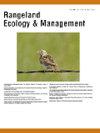Patch-Burn Grazing is Similar to Annual Burning in Effects on Belowground Invertebrates in Tallgrass Prairie
IF 2.4
3区 环境科学与生态学
Q2 ECOLOGY
引用次数: 0
Abstract
Patch-Burn Grazing (PBG) is a rangeland management strategy that aims to promote heterogeneity across a landscape by burning rotating discrete patches of land, which draws cattle to the most recently burned areas. This is in contrast to Annual-Burn Grazing (ABG), which is a commonly used management practice across the rangelands of the midwestern United States that tends to homogenize the grazing landscape. PBG has been thought to promote biodiversity of a variety of taxa, including birds, small mammals, and plants. However, the impacts of PBG on invertebrate communities are not well understood. Here we investigate the effects of these alternative fire-grazing management strategies on soil-dwelling invertebrate communities in a tallgrass prairie rangeland ecosystem. Specifically, we examine the effects of each management style on overall biodiversity and variability of belowground invertebrates across the landscape, as well as the responses within individual burn areas of PBG. We found that soil-dwelling invertebrate richness at the plot-scale was higher in ABG compared to PBG, while community composition and abundance did not differ between the two management methods. Additionally, richness, evenness, and abundance of belowground invertebrates did not differ across the PBG landscape based on years since burning. Finally, beta-diversity of belowground invertebrates across the landscape did not differ between PBG and ABG. Overall, our results suggest that PBG does not differ from ABG in its impact on biodiversity in belowground invertebrate communities. Further research investigating why some taxa (e.g., birds, small mammals) respond differently than others (e.g., belowground invertebrates) would help inform land management decisions across the region. Understanding these dynamics expands our insights surrounding how heterogeneity driven by fire-grazing interactions impacts rangeland invertebrates.
斑块燃烧放牧对高草草原地下无脊椎动物的影响与年度燃烧相似
斑块燃烧放牧(PBG)是一种牧场管理策略,旨在通过燃烧旋转的离散斑块土地来促进景观的异质性,从而将牛吸引到最近被烧毁的地区。这与每年燃烧放牧(ABG)形成对比,ABG是美国中西部牧场普遍使用的一种管理做法,往往会使放牧景观同质化。PBG被认为可以促进多种分类群的生物多样性,包括鸟类、小型哺乳动物和植物。然而,PBG对无脊椎动物群落的影响尚不清楚。在这里,我们研究了这些替代的火放牧管理策略对高草草原草地生态系统中土栖无脊椎动物群落的影响。具体而言,我们研究了每种管理方式对景观中地下无脊椎动物的整体生物多样性和可变性的影响,以及PBG个别燃烧区域内的响应。研究发现,样地尺度上ABG的土壤无脊椎动物丰富度高于PBG,而群落组成和丰度在两种管理方式之间没有差异。此外,地下无脊椎动物的丰富度、均匀度和丰度在PBG景观中没有基于燃烧后年份的差异。最后,地下无脊椎动物的β -多样性在PBG和ABG之间没有差异。总体而言,我们的研究结果表明,PBG对地下无脊椎动物群落生物多样性的影响与ABG没有什么不同。进一步研究为什么一些分类群(如鸟类、小型哺乳动物)与其他分类群(如地下无脊椎动物)的反应不同,将有助于为整个地区的土地管理决策提供信息。了解这些动态扩展了我们对由火放牧相互作用驱动的异质性如何影响牧场无脊椎动物的见解。
本文章由计算机程序翻译,如有差异,请以英文原文为准。
求助全文
约1分钟内获得全文
求助全文
来源期刊

Rangeland Ecology & Management
农林科学-环境科学
CiteScore
4.60
自引率
13.00%
发文量
87
审稿时长
12-24 weeks
期刊介绍:
Rangeland Ecology & Management publishes all topics-including ecology, management, socioeconomic and policy-pertaining to global rangelands. The journal''s mission is to inform academics, ecosystem managers and policy makers of science-based information to promote sound rangeland stewardship. Author submissions are published in five manuscript categories: original research papers, high-profile forum topics, concept syntheses, as well as research and technical notes.
Rangelands represent approximately 50% of the Earth''s land area and provision multiple ecosystem services for large human populations. This expansive and diverse land area functions as coupled human-ecological systems. Knowledge of both social and biophysical system components and their interactions represent the foundation for informed rangeland stewardship. Rangeland Ecology & Management uniquely integrates information from multiple system components to address current and pending challenges confronting global rangelands.
 求助内容:
求助内容: 应助结果提醒方式:
应助结果提醒方式:


